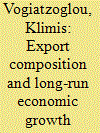| Srl | Item |
| 1 |
ID:
113004


|
|
|
|
|
| Publication |
2012.
|
| Summary/Abstract |
The volume of China's high-technology exports has grown sharply since the implementation of its export promotion strategy "Revitalizing Trade through Science and Technology" in 1999. This paper investigates whether technology spillover effects are greater for high-technology exports than for primary manufactured goods exports. We present a generalized multi-sector spillover model to identify both between-spillover effects from exports towards non-exporters and within-spillover effects among export sectors. Using panel data for 31 provinces in China over the period from 1998 to 2005, we find that although high-technology export sectors have higher productivity compared with other sectors, this productivity advantage does not lead to technology spillover to both domestic sectors and other export sectors, and export technology spillover mainly derives from traditional export sectors rather than high-technology export sectors. As such findings can be largely attributed to the fact that China's high-technology exports depend significantly on processing trade by foreign-invested firms, policy implications are discussed in relation to how to best promote the role of China's high-technology exports during economic expansion.
|
|
|
|
|
|
|
|
|
|
|
|
|
|
|
|
| 2 |
ID:
164422


|
|
|
|
|
| Summary/Abstract |
Export expansion can be a significant engine of economic growth for developing economies. The size of the growth effect of exports depends not only on volume but also on the sectoral composition of exports. By explicitly considering the sectoral export composition, this article examines over a 31-year period the long-run growth impact of exports in four transition and emerging economies of the Association of Southeast Asian Nations (ASEAN), namely Cambodia, Laos, Myanmar and Vietnam. More specifically, for each country, a long-run equilibrium analysis within a cointegration framework is conducted for three broad sectors (agriculture, mining/natural resources and manufacturing) as well as for 22 manufacturing industries during 1987–2017. The results indicate that there has been sizeable export expansion (especially in Vietnam), but export composition differs substantially across economies, which has an effect on the overall growth impact of the country’s exports. Clear evidence of export-led growth is found only for some sectors. Countries that rely heavily on primary goods have experienced relatively lower export-led growth. Export restructuring in manufacturing industries is associated with a larger long-run growth effect for a country’s exports. Our findings suggest that policies encouraging diversification away from traditional export sectors would be expected to lead to higher long-run growth effects of exports. Furthermore, our analysis implies a steady strengthening of export dynamism in ASEAN ‘latecomer’ economies and their rising significance in the global trade system.
|
|
|
|
|
|
|
|
|
|
|
|
|
|
|
|